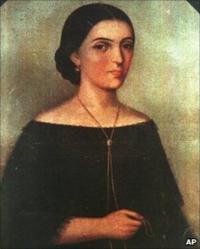
Independence liberated many countries from Spanish rule but the aftermath was more complex. There were many revolutionary leaders that were later exiled from their home countries. Two of which was the liberator of many, Simon Bolívar and his lover Manuela Sáenz, a native of Ecuador.
Manuela Sáenz has been discussed by scholars for a long time, mainly for her romantic relationship with Bolívar, who was arguably the most famous liberator in Latin America. Sáenz stood alongside Bolivar throughout his triumphs and tragedies. After Bolívar’s death, she was exiled from modern Colombia and journeyed back to her homeland of Ecuador where she was turned away (Murray, 292).
Despite her exile, Sáenz kept in contact with Ecuadorian leaders in the 1830s and 1840s.These letters were written to multiple leaders in Quito, most notably the President Don Juan José Flores who was also an ally of Simon Bolívar. In her first letter to the President in 1834, expressed her reasoning for her standing by Bolívar after he had lost his power and influence as well why she took certain objects when Bolívar was being followed. She then argues that she is innocent and should be allowed to return home and regain access to her mothers inheritance. In her second letter in 1843, she once again begins with a plea to allow her to return home and a reminder of their past friendship. She also expresses her interest in politics in Ecuador and other neighboring country as a demonstration of her admiration for both the president and the country.
In many cases, Independence was not everything that people had hoped it would be. Many things stayed the same especially social hierarchies, leaving many in the same social and economic disadvantages as they had been before. Additionally, classic liberalism, the way of thinking that led to most of the revolutions was quickly overcome by conservative thought processes which did not allow for much progress to be made (Chasteen). Sáenz was an example of someone seriously affected by the aftermath of independence. Once the partner of a famed revolutionary, she became an outcast and was forced to leave her country to live in exile but she never gave up interest and pride in her home, Ecuador.
Works Cited:
Chambers, Sarah C.. “Manuela Sáenz: Americana or Quiteña?” In The Ecuador Reader, 79-85. Durham, NC: Duke University Press, 2008.
Chasteen, John Charles. Born in Blood and Fire. 4rd edition. New York: W.W. Norton, 2016.
Murray, Pamela S. “‘Loca’ or ‘Libertadora’?: Manuela Sáenz in the Eyes of History and Historians, 1900-c.1990.” Journal of Latin American Studies 33, no. 2 (2001): 291-310. Accessed February 14, 2020. www.jstor.org/stable/3653686.
Images Cited:
Avila, Boris. “Galería.” Museo Manuela Sáenz. Museo Manuela Sáenz. Accessed February 14, 2020. http://museomanuelasaenz.com/galeria/.
Grant, Will. “Venezuela Honours Simon Bolivar’s Lover Manuela Saenz.” BBC News. BBC, July 5, 2010. https://www.bbc.com/news/10504821.
